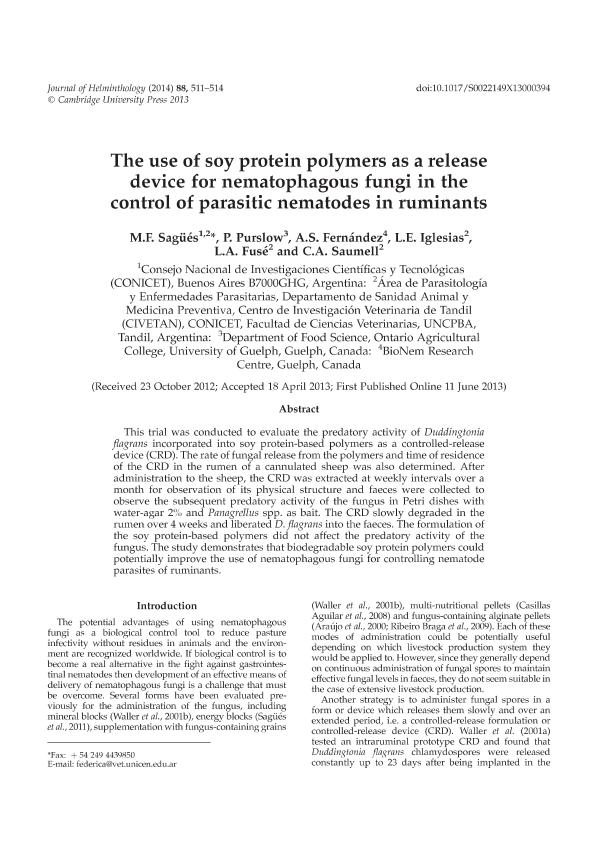Artículo
The use of soy protein polymers as a release device for nematophagous fungi in the control of parasitic nematodes in ruminants
Sagüés, María Federica ; Purslow, Peter; Fernández, Alicia Silvina
; Purslow, Peter; Fernández, Alicia Silvina ; Iglesias, Lucía Emilia; Fusé, Luis; Saumell, Carlos Alfredo
; Iglesias, Lucía Emilia; Fusé, Luis; Saumell, Carlos Alfredo
 ; Purslow, Peter; Fernández, Alicia Silvina
; Purslow, Peter; Fernández, Alicia Silvina ; Iglesias, Lucía Emilia; Fusé, Luis; Saumell, Carlos Alfredo
; Iglesias, Lucía Emilia; Fusé, Luis; Saumell, Carlos Alfredo
Fecha de publicación:
12/2014
Editorial:
Cambridge University Press
Revista:
Journal Of Helminthology
ISSN:
0022-149X
Idioma:
Inglés
Tipo de recurso:
Artículo publicado
Clasificación temática:
Resumen
This trial was conducted to evaluate the predatory activity of Duddingtonia flagrans incorporated into soy protein-based polymers as a controlled-release device (CRD). The rate of fungal release from the polymers and time of residence of the CRD in the rumen of a cannulated sheep was also determined. After administration to the sheep, the CRD was extracted at weekly intervals over a month for observation of its physical structure and faeces were collected to observe the subsequent predatory activity of the fungus in Petri dishes with water-agar 2% and Panagrellus spp. as bait. The CRD slowly degraded in the rumen over 4 weeks and liberated D. flagrans into the faeces. The formulation of the soy protein-based polymers did not affect the predatory activity of the fungus. The study demonstrates that biodegradable soy protein polymers could potentially improve the use of nematophagous fungi for controlling nematode parasites of ruminants.
Archivos asociados
Licencia
Identificadores
Colecciones
Articulos(CIVETAN)
Articulos de CENTRO DE INVESTIGACION VETERINARIA DE TANDIL
Articulos de CENTRO DE INVESTIGACION VETERINARIA DE TANDIL
Citación
Sagüés, María Federica; Purslow, Peter; Fernández, Alicia Silvina; Iglesias, Lucía Emilia; Fusé, Luis; et al.; The use of soy protein polymers as a release device for nematophagous fungi in the control of parasitic nematodes in ruminants; Cambridge University Press; Journal Of Helminthology; 88; 4; 12-2014; 511-514
Compartir
Altmétricas



